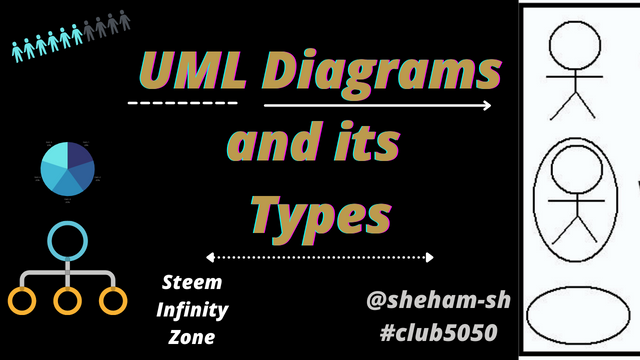SIZ Education | UML Diagram and its Types | by @sheham-sh | #club5050
Greetings Steemians!
I'm Sheham Hassan, and in this article, I'd like to discuss UML Diagrams and their many forms, which I was recently studying and chose to write about!

Unified Modeling Language (UML)
The Unified Modeling Language (UML) is a standard language for describing, visualising, building, and documenting software system artefacts, as well as business modelling and non-software systems. The UML is a collection of best engineering practises for modelling big and complex systems that have been demonstrated to work. 1 The UML is a critical component of object-oriented software development and the software development process. To express the design of software projects, the UML primarily use graphical notations. The UML aids project teams in communicating, exploring new designs, and validating the software's architectural design.

Types of UML Diagrams
Each UML diagram is intended to allow developers and consumers to see a software system from a different angle and at different levels of abstraction. The following are examples of UML diagrams that are often developed with visual modelling tools:

Use Case Diagram
The link between actors and use cases is shown. A use case is a collection of situations that describe a user's engagement with a technology. The link between actors and use cases is depicted in a use case diagram. Use cases and actors are the two fundamental components of a use case diagram.
img source
Class Diagram
Class Diagram design features like as classes, packages, and objects are used to model the structure and contents of classes. It also shows linkages like confinement, inheritance, and affiliations.

img source
Class diagrams are frequently used to depict the many sorts of items in a system and their interactions. Class diagrams use design features like as classes, packages, and objects to represent the structure and contents of a class.

Sequence Diagram
The temporal sequence of the items involved in the interaction is depicted in the Sequence Diagram. This is made up of two dimensions: vertical (time) and horizontal (space) (different objects). By describing the objects and the messages they pass, sequence diagrams explain the behaviour of objects in a use case. The diagrams are read in decreasing order from left to right. The names of the classes the objects belong to do not have to be listed.
Collaboration Diagram
Collaboration diagrams are very simple to construct. They depict the relationship between things as well as the sequence in which messages are sent. The items are represented by icons, and arrows show how messages are exchanged between them. Sequence numbers are the numbers adjacent to the messages. They display the sequence of messages as they are exchanged between the objects, as the name implies.

State Diagram
State diagrams are used to depict a system's behaviour. State diagrams depict all of an object's conceivable states as events unfold. Each diagram generally represents a single class of objects and tracks the various states of those items throughout the system.


Activity Diagram
Activity diagrams depict a system's workflow behaviour. Because activities represent the state of doing something, activity diagrams are comparable to state diagrams. The diagrams depict the current condition of activities by depicting the order in which they were completed. Activity diagrams can depict conditional or simultaneous actions.

Goals of UML
- Provide users with a ready-to-use visual modelling language that allows them to create and share meaningful models.
- Extend the core using extensibility and specialisation features.
- Be self-contained in terms of programming languages and development processes.
- Establish a formal foundation for comprehending the modelling language.
- Promote the expansion of the market for OO tools.

That's it for my post, be sure to upvote and comment this post.
Thanks for Reading
Achievement 1
Achievement 2
#club5050

@cryptokraze | @arie.steem | @qasimwaqar | @vvarishayy | @suboohi


Good post dear friend you have a great used of markdowns on your post.
Thank you for sharing this.
Thanks 👍